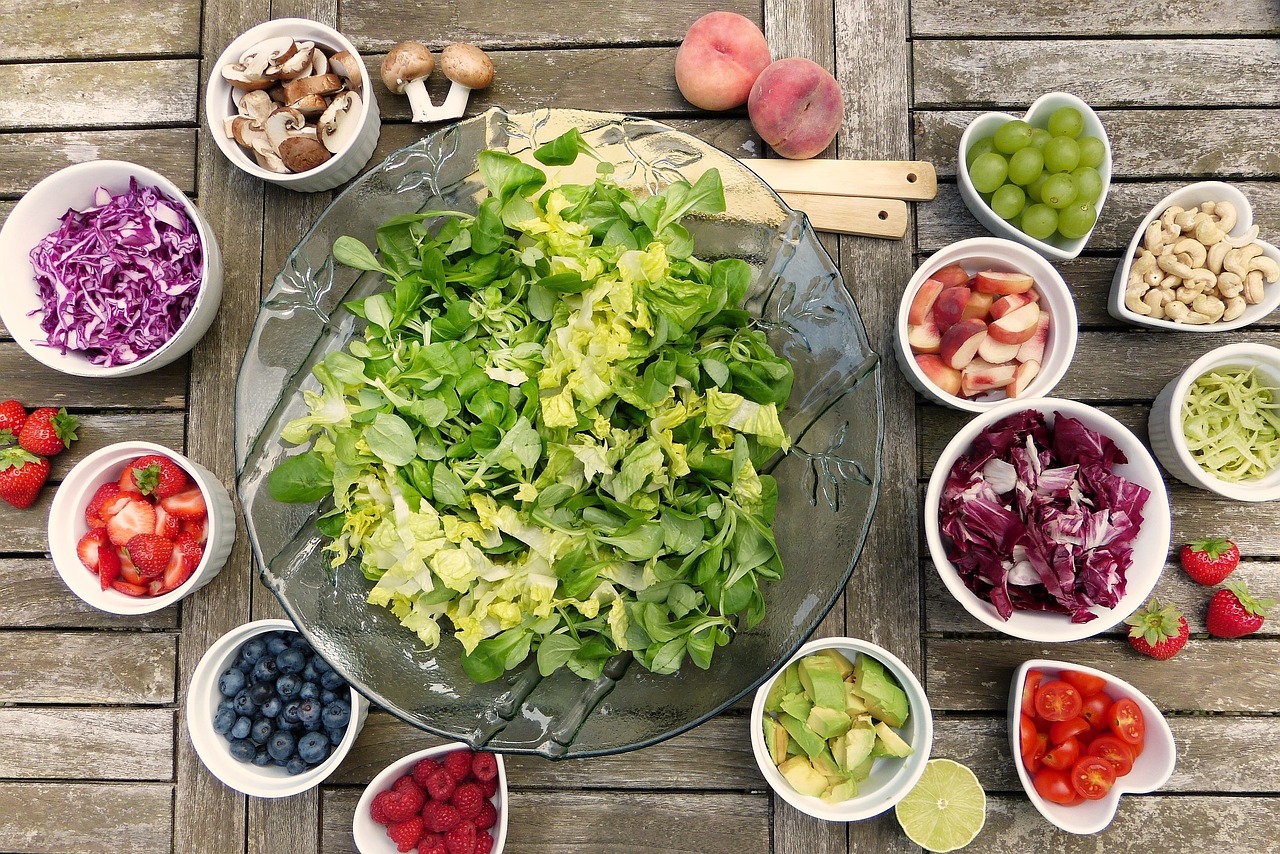
Are you struggling to find ways to get your family to eat more vegetables? Look no further! With “How Do I Get My Family To Eat More Vegetables?”, you’ll discover effective strategies and practical tips that will make vegetables a regular and enjoyable part of your family’s diet. From creative recipes to sneaky tricks, this product is your ultimate guide to transforming even the pickiest eaters into veggie lovers. Get ready to revolutionize your family’s meals and promote healthy eating habits with ease!

Creating a Positive Environment for Vegetables
Lead by Example
One of the most effective ways to encourage your family to eat more vegetables is by leading by example. When your family sees you enthusiastically incorporating vegetables into your own meals, they are more likely to follow suit. Make sure to visibly enjoy your vegetable-filled meals and showcase your appreciation for their flavors and textures. By showcasing your positive attitude towards vegetables, you can inspire your family members to develop a similar mindset.
Make Vegetables Fun and Appealing
To make vegetables more appealing to your family, it’s important to make them fun and visually appealing. Get creative with the presentation of vegetables by incorporating different shapes, colors, and textures. Consider using vegetable cutters to create interesting shapes or arranging them in colorful patterns on the plate. Additionally, you can create fun names for vegetable dishes or have themed nights where vegetables are the star of the show. The more enjoyable and exciting you make vegetables, the more likely your family will be willing to give them a try.
Involve Your Family in Meal Planning
Involving your family in the meal planning process can foster a sense of ownership and encourage their participation in eating vegetables. Allow each family member to contribute ideas for vegetable-based meals and snacks. Take the time to listen to their preferences and incorporate their suggestions into the meal plan. By involving your family in the decision-making process, they will feel more invested in the meals and be more receptive to trying new vegetable dishes.
Getting Creative in the Kitchen
Try New Vegetable Recipes
One of the best ways to encourage your family to eat more vegetables is by introducing them to new and exciting recipes. Look for creative vegetable recipes online, in cookbooks, or by attending cooking classes. Experiment with different flavor combinations, cooking techniques, and cuisines to keep things interesting. Exploring a variety of recipes will help you discover new ways to prepare vegetables and prevent your family from getting bored with the same old dishes.
Experiment with Different Cooking Methods
If your family members have been resistant to certain vegetables in the past, try experimenting with different cooking methods. Some individuals may dislike raw vegetables but find roasted or steamed vegetables more palatable. Others might enjoy the crispy texture of stir-fried vegetables or the creamy consistency of pureed vegetables. By experimenting with various cooking methods, you can identify the ones that appeal most to your family members’ taste preferences.
Sneak Vegetables into Familiar Dishes
If you have family members who are particularly picky eaters or resistant to trying vegetables, sneaking them into familiar dishes can be a great way to increase their intake. For example, you can puree vegetables and add them to sauces, soups, or even baked goods without altering the taste significantly. By gradually incorporating vegetables into their favorite dishes, you can expose your family members to their nutritional benefits without overwhelming them with new flavors.
Educating Your Family About the Benefits of Vegetables
Explain the Nutritional Value of Vegetables
Make a habit of explaining the nutritional value of vegetables to your family. Share information about their vitamin and mineral content, fiber content, and role in maintaining a healthy body. Emphasize the importance of a balanced diet that includes a wide variety of vegetables for optimal nutrition. By understanding the benefits that vegetables offer, your family members may become more motivated to incorporate them into their meals.
Discuss the Health Benefits of Eating Vegetables
Beyond their nutritional value, discuss the various health benefits associated with eating vegetables. Explain how vegetables can support digestion, boost immunity, and contribute to better heart health. Highlight specific vegetables and their unique benefits, such as carrots for eye health or leafy greens for bone strength. By discussing the positive impact vegetables can have on overall well-being, your family members may develop a greater appreciation for their importance.
Share Success Stories and Testimonials
To further motivate your family, share success stories and testimonials from individuals who have experienced positive changes by incorporating more vegetables into their diet. These stories can come from friends, family members, or even celebrities. Hearing firsthand experiences of improved energy levels, weight loss, or improved health can help inspire your own family members to give vegetables a chance. Knowing that others have had success can instill a sense of belief in the potential benefits of vegetable consumption.
Overcoming Challenges and Objections
Addressing Picky Eaters
When dealing with picky eaters, it’s important to approach their resistance with patience and understanding. Instead of forcing them to eat vegetables, gradually introduce small portions and encourage them to take at least one bite. Keep offering a variety of vegetables prepared in different ways, as taste preferences can change over time. Avoid pressuring or bribing them into eating vegetables, as this can create negative associations. Instead, focus on creating a positive and relaxed environment to encourage their curiosity and willingness to try new foods.
Dealing with Texture or Taste Issues
Texture and taste can be significant factors in a person’s resistance to vegetables. If a family member dislikes a certain texture or taste, consider offering alternatives that have similar nutritional value. For example, if someone dislikes the crunchiness of raw carrots, try offering cooked or pureed carrots as an alternative. Additionally, season vegetables with herbs, spices, or dressings to enhance their flavors and make them more enjoyable. By being flexible and adapting to individual preferences, you can make vegetables more appealing to your family.
Handling Time Constraints
Time constraints can often be a barrier to preparing and consuming vegetables. To overcome this challenge, plan ahead and dedicate specific time slots for meal preparation and cooking. Consider batch cooking on weekends or using time-saving kitchen appliances such as slow cookers or pressure cookers. Additionally, involve your family members in meal preparation to distribute the workload and make it a shared responsibility. By strategizing and finding efficient ways to include vegetables in your meals, you can overcome time constraints and prioritize their consumption.

Making Vegetables Accessible and Convenient
Keep a Well-Stocked Vegetable Inventory
Maintaining a well-stocked vegetable inventory is essential to make vegetables easily accessible for your family. Keep a variety of fresh vegetables on hand, as well as frozen vegetables for when fresh options are not available. By having a wide range of vegetables readily available, you can easily incorporate them into your daily meals and snacks. Regularly check your inventory to ensure you are replenishing vegetables before they run out.
Prep and Store Vegetables for Easy Use
To make vegetables more convenient, dedicate some time to prep and store them in advance. Wash, chop, and divide vegetables into portion sizes that are suitable for your family’s needs. Store them in airtight containers or bags in the refrigerator, making it quick and easy to grab them when needed. Preparing vegetables in advance saves time during meal preparation and eliminates the excuse of not having them readily available.
Pack Vegetables as Snacks or Lunch Options
Make vegetables a convenient snack or lunch option by packing them in reusable containers or bento boxes. Cut raw vegetables into bite-sized pieces and provide a variety of colorful options. Include a dip, such as hummus or yogurt, to enhance the taste and enjoyment. Encourage your family members to take vegetables to school or work as a healthy snack or side dish. By making vegetables easily accessible outside the home, you increase the chances of your family incorporating them into their daily routines.
Engaging in Group Activities and Initiatives
Join Community Gardens or Local Food Initiatives
Engaging in community gardens or local food initiatives can be a fantastic way to involve your family in vegetable-related activities. These initiatives provide opportunities to learn about gardening, experience the joy of growing your own vegetables, and connect with like-minded individuals. By participating in community gardens, your family can develop a deeper appreciation for vegetables while enjoying the sense of community that comes with it.
Start a Family Vegetable Challenge
Initiating a family vegetable challenge can add an element of fun and competition to the journey of eating more vegetables. Set goals and track your family’s vegetable consumption together. Create a reward system or establish a friendly competition to encourage participation. For example, you could have a weekly “Vegetable Star” award for the family member who tries the most new vegetables or be creative with different challenges to keep everyone engaged and motivated.
Participate in Cooking Classes or Workshops
Cooking classes or workshops focused on vegetables can be an excellent way to learn new recipes and cooking techniques together as a family. Look for local workshops or even online classes that cater to a range of skill levels. By participating in these activities, your family members can enhance their culinary skills, discover new ways to prepare vegetables, and foster a deeper appreciation for the role of vegetables in their diet.

Encouraging a Positive Mindset and Appreciation for Vegetables
Promote Positive Language and Attitudes
The language and attitudes used around food can significantly influence how your family perceives vegetables. Make an effort to use positive language and avoid negative associations when discussing vegetables. Instead of labeling vegetables as “boring” or “yucky,” use words like “delicious” and “nourishing” to create a positive perception. Cultivating a positive mindset around vegetables can shape the attitudes of your family members and make them more receptive to trying new varieties and flavors.
Encourage Tasting and Trying New Vegetables
Encourage your family members to taste and try new vegetables, even if they are initially hesitant. Celebrate their efforts and provide positive feedback regardless of whether they enjoy the taste or not. Encourage them to describe the flavors and textures they experience, fostering a sense of exploration and curiosity. By promoting an environment where trying new vegetables is encouraged and celebrated, your family members can develop an appreciation for the diversity of flavors that vegetables offer.
Reward and Celebrate Vegetable-Based Meals
To further encourage a positive mindset towards vegetables, consider implementing a reward system or celebration for vegetable-based meals. This could include preparing a special dish or dessert after a certain number of vegetable-packed meals. Alternatively, you could establish a family tradition of going out to a favorite restaurant that offers a wide range of vegetable-centric dishes. By rewarding and celebrating vegetable-based meals, you reinforce the value and enjoyment of incorporating vegetables into your family’s diet.
Seeking Outside Support and Resources
Consult with a Nutritionist or Dietitian
If you are struggling to get your family to eat more vegetables, consider consulting with a nutritionist or dietitian. These professionals can offer personalized advice and guidance tailored to your family’s specific dietary needs and preferences. They can help you create meal plans, identify strategies to overcome challenges, and provide additional resources to support your journey towards increased vegetable consumption.
Utilize Online Recipe Blogs and Resources
The internet is a treasure trove of recipe blogs and resources focused on vegetables. Explore reputable websites and blogs that offer a variety of vegetable-based recipes, cooking tips, and nutritional information. Many recipe blogs also provide step-by-step instructions, making it easier for you to follow along. By utilizing online resources, you can expand your culinary repertoire, discover new flavors, and find inspiration to incorporate more vegetables into your family’s meals.
Join Online Support Groups or Forums
Online support groups and forums dedicated to promoting healthy eating habits can be valuable sources of motivation and encouragement. Connect with like-minded individuals who are also on a journey to incorporate more vegetables into their family’s diet. Share ideas, challenges, and success stories with others who may be facing similar obstacles. These online communities can provide a sense of camaraderie and serve as a valuable source of support throughout your family’s vegetable journey.
Addressing Specific Dietary Needs and Restrictions
Accommodating Food Allergies or Intolerances
If a family member has food allergies or intolerances, it is crucial to accommodate their specific dietary needs when it comes to vegetables. Work closely with a healthcare professional or registered dietitian to identify suitable alternatives and substitutions. Explore a wide range of vegetables that are safe for consumption, ensuring that all necessary nutritional requirements are met. By addressing their dietary restrictions with care and consideration, you can ensure that everyone in your family can still enjoy the benefits of vegetable consumption.
Adapting Vegetables for Specific Diets (e.g., vegan, gluten-free)
If your family follows a specific diet, such as vegan or gluten-free, it is important to adapt vegetable options accordingly. With veganism, eliminating animal products means incorporating plant-based protein sources like legumes or tofu alongside vegetables. For gluten-free diets, focus on naturally gluten-free vegetables and substitute with gluten-free grains or alternatives. By being mindful of your family’s dietary restrictions and seeking suitable alternatives, you can create vegetable-based meals that align with their specific diet.
Exploring Alternative Vegetable Options
Sometimes, introducing new vegetables can be challenging due to personal taste preferences or dietary restrictions. In such cases, it can be helpful to explore alternative vegetable options that offer similar nutritional benefits. For example, if a family member dislikes broccoli but enjoys cauliflower, you can substitute cauliflower in recipes that call for broccoli. Likewise, if a family member has an aversion to leafy greens, explore alternatives like kale chips or vegetable-based smoothies. By being open to alternative vegetable options, you can still provide the necessary nutrients while catering to individual preferences.
Continuing the Journey and Maintaining Progress
Track and Reflect on Vegetable Consumption
Tracking and reflecting on vegetable consumption can help your family stay on track and maintain progress. Keep a visual record, such as a calendar or a dedicated notebook, where each family member can mark their daily vegetable intake. Review the records periodically as a family, discussing achievements and areas for improvement. This practice not only helps maintain accountability but also serves as a visual reminder of the progress made and the importance of consistently incorporating vegetables into meals.
Set Realistic and Achievable Goals
Setting realistic and achievable goals is key to sustaining long-term vegetable consumption. Start by setting small goals, such as increasing vegetable intake by one serving per day, and gradually increase the target over time. Make goals specific and measurable so that progress can be easily tracked. By setting achievable goals, you can prevent feelings of overwhelm and ensure that your family experiences a sense of accomplishment as they work towards incorporating more vegetables into their daily routine.
Celebrate Milestones and Sustain Motivation
Celebrate your family’s milestones and achievements throughout the journey of increasing vegetable consumption. Acknowledge and reward the efforts made by each family member, whether it’s trying a new vegetable or incorporating vegetables into a favorite dish. Celebrate collectively as a family by going out for a special meal or engaging in a fun activity. By celebrating milestones, you reinforce the positive association with vegetables and sustain motivation for continued progress.
In conclusion, getting your family to eat more vegetables requires a combination of inspiration, education, and creativity. By leading by example, making vegetables fun and appealing, involving your family in meal planning, trying new recipes and cooking methods, and addressing challenges, you can create a positive environment in which vegetables are embraced. Educating your family about the benefits of vegetables, making them accessible and convenient, and engaging in group activities further reinforce their importance. Encouraging a positive mindset and seeking outside support, addressing dietary needs, and maintaining progress through goal setting and celebration are vital aspects of the journey towards increased vegetable consumption. Remember, with patience, perseverance, and a friendly approach, you can successfully inspire your family to embrace the wonderful world of vegetables.
